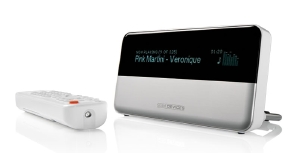
Page 3, ReadyNAS
One issue I immediately ran into was transferring about 200GB of audio files (all uncompressed WAV files) from an external USB drive into the ReadyNAS by using one of its USB ports. Although it’s touted as having a USB 2.0 port, which can transfer data up to 480 Mbps, the ReadyNAS was abysmally slow in moving the data off the external drive. Why this was so I have no idea. Instead, I ended up attaching the USB drive to a Mac and transferred the data over a wired LAN, which went far more quickly.
I had tried using several platforms, like Windows XP and MacOS X for running the SlimServer software, which in turn drove a Slim Devices Squeezebox 3 player feeding my mighty MBL 101D speakers. I have said it many times, but the MBL 101D's are not only magically musical, but also a terrific reviewer’s tool as every change in the system is instantly revealed, for better or worse.
 The Squeezebox
The Squeezebox
When I had previously switched between running Slimserver on Win XP or MacOS X, I heard no sonic difference, save for the great musical quality of the Slim Devices software and hardware, a killer combo that opened up a big can of whoop-ass on digital audio gear costing several thousand dollars. I thus expected the same with the ReadyNAS NV+. Not so! What I heard caught me totally off guard, and to this day I still cannot figure out what the hell is going on.
The ReadyNAS NV+ with its embedded Linux running SlimServer blew away not only using Win XP and MacOS X, but also many high-end digital source components that start at around $5,000. The sound stage expanded way out yet again, causing a need for maybe a next-door sublet; the black, silent background went into total solar eclipse; and everything else, including musical pace, rhythm, and timbre all improved, all not by just a little, but by a lot.
The newly enhanced definition and precision of exactly placed instruments totally floored me. None of this improvement was you-gotta-strain-your-ears-to-hear-it subtle. All of which is to say, the ReadyNAS/Seagate combination pushed my high-end rig up another whole notch, which is really saying something.
As I said, I am clueless why this huge improvement in musical quality happened. Nothing else had been changed, except for running Slimserver on the ReadyNAS instead of on my Mac, which has the latest version of MacOS X. I was using the exact same music files, in the same uncompressed WAV format, and the same decoders and Squeezebox as before. My MBL 101D speakers were certainly the same, and nothing else had changed in my audio rig, either; same Nordost Valhalla speaker cables and interconnects, same Sunfire amplifiers and preamplifier, and the same Nordost Thor power conditioner.
Was it a difference in operating systems? That makes no sense, as Linux and MacOS X both spring from the same UNIX family tree. Is it because the ReadyNAS NV+ is running an embedded, dedicated OS with much less overhead than the general purpose Win XP and MacOS X? Could it have been a lower noise floor in the power supply (always a big design issue in audio) of the ReadyNAS NV+? Or was it the Seagate Barracuda drives with their advanced error correction and other failure-proof capabilities? Or was it some mysterious brew of all the above? I don’t have the foggiest.
Regardless, it should not have been happening, and it opens wide the high-end door to a brand new discussion of bits-are-bits, what-are-bits, and what-does-this-all-mean? It would seem the high-end has a completely different realm to explore, especially as systems in the home increasingly go all digital with networked media distribution from central servers.
Another issue also became unavoidably apparent during this review—Beware of wireless whole house distribution of A/V media, especially if you live in a neighborhood chock a block with WiFi networks. I live in a 37 story high-rise that seems to have more promiscuously broadcasting WiFi LANS than residents. The interference finally got to me, because the wireless data link to the Squeezebox was crapping out way too often. It had reached the point where I could no longer trust the system for an extended listening session without aggravating interruption.
21st, The VXM Network, https://vxm.com